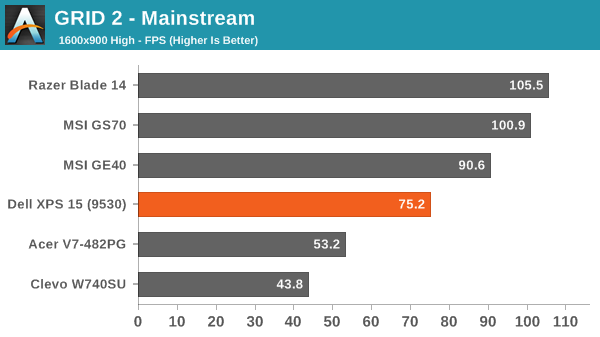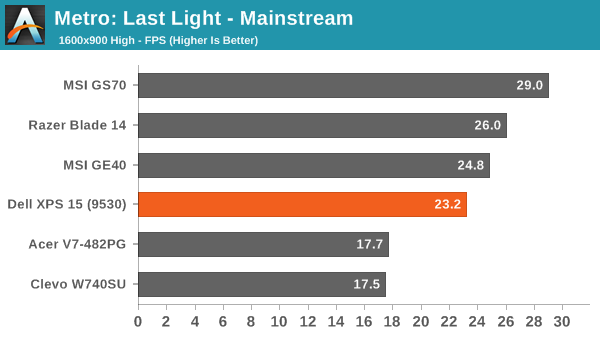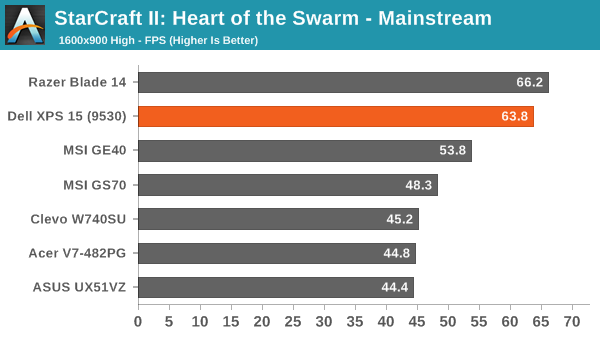Dell XPS 15 Haswell Edition: QHD+ with a Refined Design
by Jarred Walton on March 6, 2014 7:00 AM ESTDell XPS 15: Gaming Performance
With that lengthy preface about throttling, let’s just make it clear that all of the benchmark results here are from post-reboot testing, so throttling should not be present. What we find is that the GT 750M is a reasonable mainstream mobile GPU that can easily handle our “Value” settings and outside of the most demanding titles (e.g. Metro: Last Light) it can run our “Mainstream” settings as well. Not surprisingly, “Enthusiast” quality is mostly out of the question, except with older and/or less demanding titles. As for gaming at the native 3200x1800 resolution, that’s generally more than you can hope to get out of the GT 750M. Some games will certainly break 30 FPS at low to moderate settings, but in most cases opting for a lower resolution with higher quality settings will provide the better experience.
I also want to make note here that with 2014, we’re going to be reducing the number of games we test in our laptop reviews. There’s a real concern that running too many GPU-centric tests can distract from the overall target market for a device. While I’ve gone ahead and included most of the games from our 2013 test suite in Mobile Bench, moving forward we have decided to focus on just four games. Our current list consists of Bioshock Infinite, GRID 2, Metro: Last Light, and StarCraft II: Heart of the Swarm. These should provide a sufficient amount of data that we’ll be able to say how well a system handles gaming workloads. In some reviews we will also include other titles (e.g. if there’s a new GPU that warrants additional investigative work), including some less demanding games that will better illustrate the “casual gaming” aspect.




Considering this isn’t really being targeted at a gaming audience – Dell has their Alienware brand if that’s what you’re after – the XPS 15 still manages to hold its own in the gaming tests. Throttling concerns aside, when the fans and GPU are running as expected, gaming at one fourth the native resolution and high detail settings is easily accomplished, and even 1080p medium/high detail is possible.










152 Comments
View All Comments
oleguy682 - Thursday, March 6, 2014 - link
I understand the desire for 16:10 in place of 16:9. But if both are 1800 lines, do you really notice the missing 200 pixels at the bottom? I realize that the AR will resize a displayed window slightly, but it would be interesting to see the actual difference between what is displayed on 16:10 vs. 16:9 on a similar document or webpage that is scaled appropriately for the AR. Unfortunately my 4:3 screen only will give me a 16:10 or 5:3 (16:9.6 or so) AR so I can't really make the comparisons myself.Fox5 - Thursday, March 6, 2014 - link
I had this laptop. I actually had a hell of a time with the intermittent throttling. Believe it or not, it happens fastest and most often with simpler games. Also, I had heavy display corruption with Steam Big Picture mode when using the nvidia gpu.Dell eventually fixed the throttling by replacing the heatsink and fan assembly. It's a tiny piece of hardware too. The corruption in Big Picture mode is still there though.
Silma - Thursday, March 6, 2014 - link
I haven't had any throttling issue since november but then again I'm not using it to play.unni - Thursday, March 6, 2014 - link
If you keep it on a level surface, there doesn't seem to be any throttling. Also, try nVidia inspector and set FPS to 30. That helps as well.Fox5 - Sunday, March 9, 2014 - link
Lol, locking the fps to 30 shouldn't be required. Also, the level surface did nothing for it. I had a legitimately defective model, and replacing the heatsink fixed it.whyso - Thursday, March 6, 2014 - link
Good that they fixed the throttling. I had a 2nd gen model that would idle at 60 degrees and reach over 100 degrees on games like skyrim.Interesting to see that the 750m performs very closely to the 765m in the razer blade.
Also, would it be possible to do some sort of test to see if the PCI-E SSD in the mac lineup actually brings any advantages? Random performance isn't better than anything else out there. Copying files to anything other than a SSD won't be different. The Macbook air reviewed didn't boot up any faster than the 2012 model either. What exactly are the advantages and are they even apparent?
VisionX302 - Thursday, March 6, 2014 - link
I tested the performance of both of these. The Mac was around 1 Gb/s while the Dell was in the 500 Mb/s range. For most real-life activities you wouldn't notice a big difference, but I could a difference in copying files, booting, resuming from sleep, etc.tipoo - Thursday, March 6, 2014 - link
I wonder if it's the same issue, my Studio 15 after some days/hours use would always lock itself at the minimum clock multiplier, had to reset to fix it. I could also fix it through forcing multipliers through Throttlestop, which was also good for me since on Penryn processors they could be undervolted so much that the top clock could use the bottom clocks voltage.tipoo - Thursday, March 13, 2014 - link
And do the larger battery sizes change the size (do they jut out like older models) and how much do they change the weight?superflex - Thursday, March 6, 2014 - link
Jarred,Why make the comparison to the retina MBP in the intro if you dont provide a comparison to the MBP in the charts?
Full retard, baby.